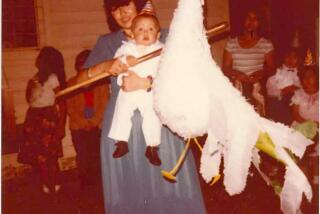PERSPECTIVE ON WOMEN : The Tender Trap of <i> Madrecita</i> : Mesoamerican heritage commands a special reverence for mothers; in our world, it means opportunities denied.
- Share via
This is the day for large, lavish, extravagantly decorated greeting cards carrying the simple message of love, “A Mi Madrecita Querida En Su Dia,” for the dedication, abnegation and self-sacrifice that is associated with motherhood in the Spanish-speaking world. It is an image celebrated in popular culture throughout the year. There is hardly a sitcom or soap opera that does not have a mother character to whom the others turn for advice, consolation, love.
This image of the mother as a respected, even revered figure is ingrained in the roots of cultural identity throughout the Latin and Mesoamerican world. In Aztec Pre-Columbian culture, the newborn female’s umbilical cord was buried next to the household hearth in order to tie her symbolically to the home. The Spanish Conquest brought with it a similar view, this time embodied in the image of the Madonna, the mother of Christ, upholding a standard impossible for ordinary mortal women: virgin mother.
Today, and certainly in reference to the violent events of 10 days ago, the mother’s place as the focal point of the family has potent relevance. More than one political leader has applauded the time-honored institutions of family and home in the Latino community for their contribution to the stability of society and the social order. What has never been questioned, however, is to what degree this female commitment inhibits and denies educational development and empowerment to Latinas.
This is not to imply that Latinas alone are denied access to higher education; males, too, are heavily under-represented in the American Council on Education’s recent annual report on minorities in higher education: From 1978 to 1988, Latino enrollment at four-year institutions increased, from 2.6% to 3.6%; at two-year institutions, from 5.6% to 7.9%. But the area that best reflects the differences in achievement between males and females continues to be at the terminal degree level. While more women than men continue to be enrolled at the undergraduate level, and the number of females obtaining master’s degrees in 1989 exceeded the number of males (3,910 to 3,360), the trend reverses at the professional and doctoral level. In 1989, 1,367 Latino men and 887 women obtained professional degrees; 307 men and 263 women received doctorates.
No one can deny that the emphasis on traditional values exacts a toll in brain drain among women. In an article in a recent issue of Hispanic Outlook in Higher Education, Monica Sanchez refers to the “social and cultural customs that regard (women’s) education and work as secondary,” reflecting their customary second-class status. Societal pressures still demand that daughters remain in their parents’ house until marriage; they will then dedicate themselves to husband and children.
And this pattern begins at an early age. Too often, the eldest female child is frequently absent from school because there is no one to help take care of the younger siblings. She assumes the role of the “little mother,” and traditional values become firmly fixed in a new generation. On a subconscious level, the characteristics of self-abnegation are also developed at this age. The good female child is submissive, non-questioning, eager to serve and to please, all personality traits that can hardly be viewed as contributing to academic success.
Too frequently as well, the Latina entering the university is viewed as wasting valuable time. She is old enough to marry and bear children. Why is she still spending her time at school? If she lives on campus, she is accused of abandoning the family. The ensuing family discord can be a terrible detriment to her academic success. She may also be suspected of leading a “loose” life, thereby casting shadows on her family’s reputation and endangering her own chances for a “good” marriage. Add to these obstacles the ever-present economic pressures confronting college students today and it becomes increasingly apparent that enormous guts and fortitude are needed to overcome all these barriers.
So let’s take a good long look at those cards and their greetings today, for they carry a sobering message. Maybe these traditions, positive as they are, merit examination and change. Society at large cannot afford to allow women to continue to be sacrificed for the comfort of others.


